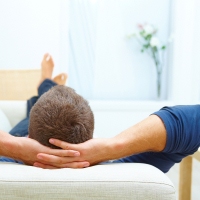 You need to take some time out to observe and stay in touch with yourself – your constant although not always conscious physical, emotional, mental and spiritual experiences of the day. This observing self is often only possible when you maintain a level of relaxation where the ‘observer’ can ‘be and function’.
You need to take some time out to observe and stay in touch with yourself – your constant although not always conscious physical, emotional, mental and spiritual experiences of the day. This observing self is often only possible when you maintain a level of relaxation where the ‘observer’ can ‘be and function’.
Planned relaxation calms anxiety and helps your body and mind recover from everyday rush and stress. Music, a long soak in the bath, or a walk in the park do the trick for some people, but for others it’s not so easy. If you feel you need help with learning to relax, try a relaxation or meditation class. Your GP and local library will have information about these.
- Choose a quiet place where you won’t be interrupted.
- Before you start, do a few gentle stretching exercises to relieve muscular tension.
- Make yourself comfortable, either sitting or lying down.
- Start to breathe slowly and deeply, in a calm and effortless way.
- Gently tense, then relax, each part of your body, starting with your feet and working your way up to your face and head.
- As you focus on each area, think of warmth, heaviness and relaxation.
- Push any distracting thoughts to the back of your mind; imagine them floating away.
- Don’t try to relax; simply let go of the tension in your muscles and allow them to become relaxed.
- Let your mind go empty. Some people find it helpful to visualise a calm, beautiful place such as a garden or meadow.
- Stay like this for about 20 minutes, then take some deep breaths and open your eyes, but stay sitting or lying for a few moments before you get up.
Practising a regular relaxation routine
It’s important that you make time to practise a thorough routine on a regular basis. There are plenty of resources out there to help you do this – the anxiety section lists just a few.
Relaxation is one of the most effective self-help activities for mental health. It can be a useful addition to any other form of treatment as well as being an effective measure to prevent the development of stress and anxiety, and at the end of the day to help you sleep.
Relaxation exercises can be divided into two broad categories: those for the body and those for the mind. Body-centred exercises also have an effect on the mind. Having a relaxed body may not prevent a constant flow of anxiety-inducing thoughts but it’s a good basis for getting some control of them. So for best results try to combine the two techniques.”
A routine to start your day is very good and a thoughtful one that supports your quest for inner balance, which is the difference between a grounded day with a sense of humour or a scattered stressful day. It is the routine itself that allows the relaxed feeling.

Wow, awesome weblog layout! How long have you ever been blogging for?
you make blogging glance easy. The full look of your web site is excellent, as well as the content material!
You can see similar here sklep online
Your point of view caught my eye and was very interesting. Thanks. I have a question for you.
Your article helped me a lot, is there any more related content? Thanks!
Your article helped me a lot, is there any more related content? Thanks!
Thank you for your sharing. I am worried that I lack creative ideas. It is your article that makes me full of hope. Thank you. But, I have a question, can you help me?